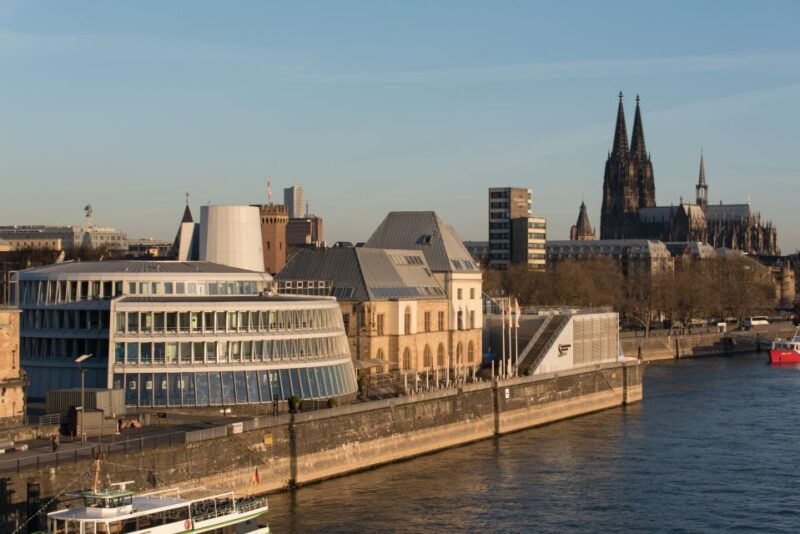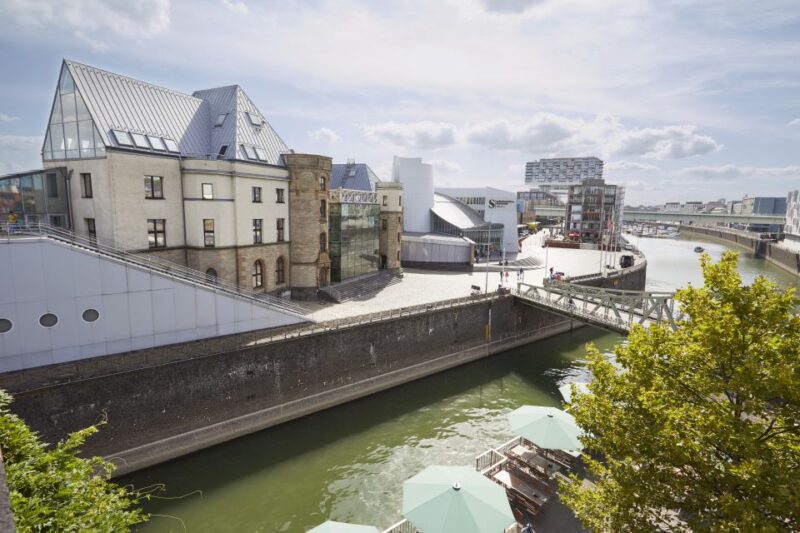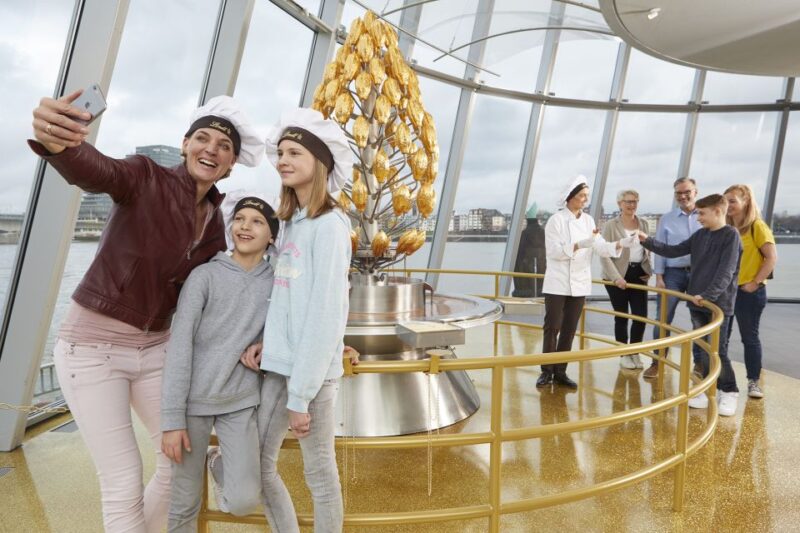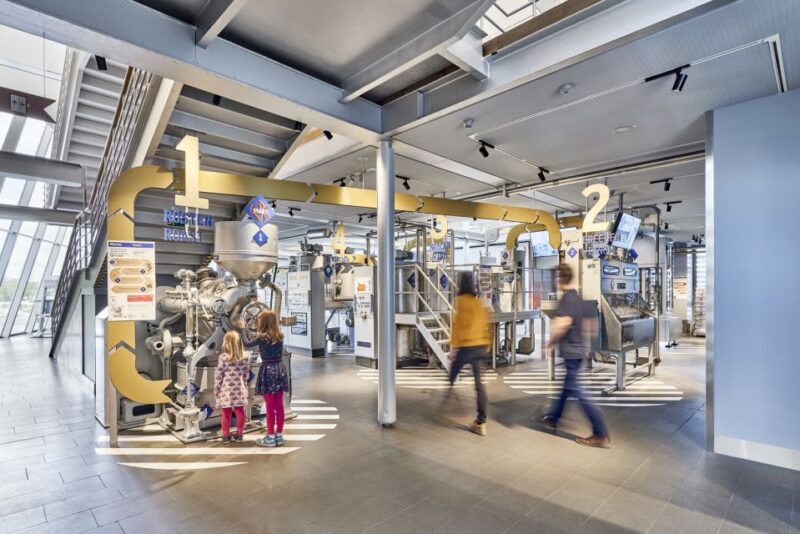Visiting the Cologne Chocolate Museum is a delectable experience for any chocolate enthusiast. Housed in an impressive 43,055 square feet space, the museum takes visitors on a captivating 5,000-year cultural journey through the history of cocoa and chocolate. From the ancient Mesoamerican civilizations to the modern chocolate-making process, the museum offers a comprehensive exploration of this beloved treat. Featuring a glass chocolate factory, a towering 3-meter-high chocolate fountain, and a wealth of historical exhibits, the Cologne Chocolate Museum promises to satisfy the senses and pique the curiosity of all who step through its doors.
Key Points

- The Chocolate Museum in Cologne offers an immersive 5,000-year cultural journey through the history of cocoa and chocolate.
- The museum features a glass chocolate factory showcasing the chocolate-making process, including a 3-meter-high chocolate fountain for tastings.
- Visitors can explore exhibits on the botanical origins of the cacao tree, as well as pre-Columbian and Baroque-era cocoa and chocolate artifacts.
- The museum provides insights into the significance of cocoa in ancient Mesoamerican cultures and the evolution of chocolate in Europe.
- The entrance ticket allows access to the museum’s expansive 43,055 square feet space, offering a must-visit destination for chocolate lovers.
Chocolate Museum Overview

The Chocolate Museum in Cologne offers visitors a 5,000-year cultural journey through the history of cocoa and chocolate, from its origins in pre-Columbian civilizations to its evolution and influence in Europe over the centuries.
Spanning an impressive 43,055 square feet, the museum takes guests through engaging exhibits on the natural history of cocoa, the arrival of chocolate in Europe, and its transformation over the decades.
At the heart of the experience lies a glass chocolate factory, where visitors can witness the magic of chocolate-making and indulge in the rich aroma of a towering 3-meter-high chocolate fountain.
The Chocolate Museum is a must-visit destination for any chocolate lover seeking to uncover the captivating past and present of this beloved treat.
Here are more great tours and experiences we've reviewed in Cologne
Cultural History of Cocoa and Chocolate

Spanning over 5,000 years, the cultural history of cocoa and chocolate traces back to pre-Columbian civilizations in Central America, where the revered cacao plant was cultivated and its seeds transformed into a sacred beverage.
The Chocolate Museum in Cologne takes visitors on a journey through this rich legacy:
- Discover how chocolate first arrived in Europe and how it evolved over the centuries, from a luxury item to a mass-produced treat.
- Explore the significance of cocoa in the lives of ancient Mesoamerican cultures, where it was considered a gift from the gods.
- Learn about the Baroque period’s influence on chocolate, reflected in the museum’s collection of porcelain and silver artifacts.
- Witness the modern-day chocolate-making process in the museum’s glass chocolate factory.
Chocolate’s Journey to Europe

Chocolate’s journey to Europe began in the early 16th century when Spanish conquistadors encountered the cacao plant in the Americas. They were captivated by the rich, flavorful beverage made from its seeds and soon introduced it to the Spanish court, marking the start of chocolate’s evolution from a sacred Mesoamerican drink to a luxury item in the Old World.
| Key Dates | Event | Impact |
|---|---|---|
| Early 1500s | Cacao introduced to Spain | Chocolate becomes a status symbol |
| 1600s | Chocolate production spreads to other European countries | Chocolate’s popularity grows across the continent |
| 1800s | Industrial revolution leads to mass production | Chocolate becomes more affordable and widely available |
As chocolate gained popularity, its preparation and consumption evolved, eventually leading to the creation of the beloved chocolate bars, truffles, and other confections we enjoy today.
Expansive Glass Chocolate Factory
The museum’s expansive glass chocolate factory allows visitors to witness the intricate process of chocolate-making firsthand, captivating them with its dynamic production line and mesmerizing chocolate fountain.
Spanning an impressive 43,055 square feet, this state-of-the-art facility showcases the transformation of cocoa beans into delectable chocolate treats.
Visitors can observe:
- The tempering and molding of chocolate in the atelier
- The meticulously crafted chocolate sculptures and artistic displays
- The intricate piping and decorating techniques used to create exquisite chocolate confections
- The towering 3-meter-high chocolate fountain, where guests can indulge in tastings of the museum’s finest creations.
This immersive experience allows visitors to gain a deeper appreciation for the time-honored art of chocolate-making.
More Great Thing To Do NearbyTropical House and Natural History
Visitors to the Chocolate Museum can explore a tropical house showcasing the natural history of cocoa, providing an immersive look at the origins and cultivation of this key ingredient. The tropical house features interactive exhibits detailing the botanical origins of the cacao tree, its growth and harvesting, as well as the fermentation and drying processes that transform the raw beans into the rich chocolate we know and love.
| Cocoa Cultivation | |
|---|---|
| Botanical Origins | Cacao tree (Theobroma cacao) |
| Growth Stages | Flowering, pod development, harvesting |
| Post-Harvest | Fermentation, drying, sorting |
| Sustainability | Fair trade, organic practices |
Ready for more culture? More museums we feature in Cologne
Pre-Columbian Cocoa Exhibits
Beyond the tropical house, the Chocolate Museum explores the pre-Columbian cultures of Central America that first cultivated and revered cocoa. Visitors can discover ancient artifacts, art, and traditions that demonstrate the deep cultural significance of this precious crop long before it reached Europe.
The museum’s exhibits feature:
- Intricate carvings and sculptures depicting the ritual use of cocoa in Mayan and Aztec civilizations
- Elaborately decorated ceramic vessels used for drinking cocoa-based beverages
- Hieroglyphic inscriptions and codices that chronicle the history and mythology surrounding cocoa
- Insights into the cultivation and processing techniques developed by indigenous peoples over millennia
Baroque Porcelain and Silver
Alongside the pre-Columbian artifacts, the museum showcases a dazzling collection of Baroque porcelain and silver that illustrates how chocolate’s popularity swept through Europe during the 17th and 18th centuries.
Visitors can admire the intricate designs and exquisite craftsmanship of the period, which highlight the growing fascination with this exotic delicacy.
From delicate tea sets to ornate chocolate pots, the exhibits showcase the ways in which chocolate was integrated into the lavish lifestyles of the European elite.
These rare and valuable pieces provide a glimpse into the opulent world of Baroque society and the cultural significance of chocolate during this golden age.
Chocolate Tasting Fountain
A towering, 3-meter-high chocolate fountain invites visitors to indulge their senses, tempting them with the rich, velvety flow of warm, melted chocolate.
This decadent feature of the Cologne Chocolate Museum allows guests to sample the smooth, silky goodness that has captivated chocolate lovers for centuries.
Visitors can dip freshly-made wafers, fruits, or other treats into the flowing chocolate, satisfying their cravings with each delectable bite.
The fountain serves as a centerpiece, showcasing the museum’s commitment to celebrating the art and history of chocolate-making.
Guests can learn about the origins of chocolate and witness the transformation of cocoa beans into the beloved confection.
This interactive experience offers a sensory delight, inviting visitors to truly enjoy the world of chocolate.
Frequently Asked Questions

Can I Bring My Own Food and Drinks Into the Museum?
Visitors are not allowed to bring their own food and drinks into the Chocolate Museum. The museum has its own cafes and restaurants where visitors can purchase refreshments to enjoy during their visit.
Are There Any Age Restrictions for Children?
Children under 12 years must be accompanied by a paying adult to enter the Chocolate Museum. There are no other age restrictions, allowing families to explore the museum’s exhibits and experiences together.
How Long Does the Guided Tour Usually Last?
The guided tour at the Chocolate Museum in Cologne generally lasts around 60 minutes. Visitors can explore the museum’s exhibits and learn about the rich history and production of chocolate during this informative tour led by knowledgeable staff.
Are There Any Discounts Available for Students or Seniors?
Yes, the Chocolate Museum offers discounted tickets for students and seniors. Students can purchase tickets for $12.72, while seniors over 60 can get tickets for $14.84. These discounted rates provide a savings of around 25% off the regular admission price.
Can I Take Pictures and Videos Inside the Museum?
Yes, visitors can take photos and videos throughout the Chocolate Museum. Photography and filming are generally permitted, though some areas may have restrictions to avoid disruptions. Visitors should check with staff for any guidelines or limitations.
Recap
The Cologne Chocolate Museum offers a captivating journey through the rich cultural history of cocoa and chocolate.
Visitors can explore the origins of this beloved treat, from ancient Mesoamerica to its arrival in Europe, and witness the evolution of chocolate production and presentation.
With its immersive exhibits and the towering chocolate fountain, the museum is a must-visit destination for any chocolate enthusiast.
You can check if your dates are available here:More Tour Reviews in Cologne
- Private Audio Book City Rally Around Cologne Cathedral and the Old Town
- Traditional German Food and Cologne Old Town Private Tour
- Cologne Hotels to Cologne Bonn Airport (Cgn) – Departure Private Transfer
- Cologne: 1-Day Private Tour to Frankfurt by Car
- Cologne: Bergen-Belsen Concentration Camp Private 1-Day Tour
- Exciting Murder Mystery – Interactive City Walk in Cologne
Not for you? Here's more things to do in Cologne we have recnetly reviewed
- 2 Best Dining Experiences In Cologne
- 2 Best Dinner Tours In Cologne
- 3 Best Shopping Tours In Cologne
- 2 Best Lunch Experiences In Cologne
- 3 Best Food Tours In Cologne
- 2 Best Private Car With Driver Services In Cologne
- 9 Best Cruises And Boat Tours In Cologne
- Jewish Quarter History Walking Tour in Cologne’s Old Town
- Cologne Self Guided Sherlock Holmes Murder Mystery Game
- Cologne Old Town Highlights Private Walking Tour
- 5 Hours Cologne to Aachen Train Tour in Germany
- Cologne Bonn Airport (Cgn) to Bonn Hotels – Arrival Private Transfer
